Personally, I'd go for a manual solution:
library(ggplot2)
plot.arr <- function(df, pointsiz=2, pointsiz.scale.factor=100){
## calculate weights to adjust for aspect ratio
norm2 <- function(v) sqrt(sum(v^2))
w <- c(diff(range(df[ ,c("x1","x2")])), diff(range(df[ ,c("y1","y2")])))
w <- w/norm2(w)
## use "elliptical" norm to account for different scales on x vs. y axes
norm2w <- function(v) sqrt(sum((v/w)^2))
## compute normalized direction vectors, using "elliptical" norm
direc <- do.call("rbind",lapply(1:nrow(df), function(i) {
vec <- with(df[i, ], c(dx=x2-x1, dy=y2-y1))
data.frame(as.list(vec/norm2w(vec)))
}))
## "shift back" endpoints:
## translate endpoints towards startpoints by a fixed length;
## translation direction is given by the normalized vectors;
## translation length is proportional to the overall size of the plot
## along both x and y directions
## pointsiz.scale.factor can be decreased/increased for larger/smaller pointsizes
epsil <- direc * diff(range(df)) / pointsiz.scale.factor
df$xend2 <- df$x2 - epsil$dx
df$yend2 <- df$y2 - epsil$dy
g <- ggplot(df) +
geom_point(aes(x=x1, y=y1), size=pointsiz) +
geom_point(aes(x=x2, y=y2), size=pointsiz) +
geom_segment(aes(x=x1, y=y1, xend=xend2, yend=yend2),
arrow = arrow())
print(g)
}
set.seed(124)
##n.arr <- 1
n.arr <- 3
df <- data.frame(x1=10+rnorm(n.arr,10,400),
x2=5 +rnorm(n.arr,1),
y1=10+rnorm(n.arr,0,5),
y2=5 +rnorm(n.arr,2))
plot.arr(df)
df <- data.frame(x1=10+rnorm(n.arr,1000,4000),
x2=5 +rnorm(n.arr,1),
y1=10+rnorm(n.arr,0,5),
y2=5 +rnorm(n.arr,2))
plot.arr(df)
df <- data.frame(x1=10+rnorm(n.arr,3,4),
x2=5 +rnorm(n.arr,1),
y1=10+rnorm(n.arr,0,5),
y2=5 +rnorm(n.arr,2))
plot.arr(df, pointsiz=4, pointsiz.scale.factor=50)
Regarding your (excellent) question in the comment below: ideally, to address that properly one would perform calculations embedded within a "native ggplot" setting, as opposed to the explicit "manual" procedure above. This might be possible, but it requires much deeper, Paul-Murrell-like knowledge, which I definitely do not possess. Specifically: after the third plot above I tried
ggsave("test1.pdf", width=6, height=6)
ggsave("test2.pdf", width=16, height=6)
Using a larger width has the side effect of stretching the distance between the arrow point and the endpoints, because the three arrows are more or less horizontally aligned; I see no other option than manually adjusting pointsiz.scale.factor after visual inspection of the pdf files. Alas, this is definitely not "native ggplot": it is brute-force, a-posteriori trial-and-error; however, it can be shown to converge in linear personal time, provided that the aspect ratio of the pdf is fixed in advance -- new aspect ratios require new trial-and-error estimation. Similar remarks hold when using larger pointsizes: to find a visually pleasing distance between the arrow points and the point edges, I see no other option than trial-and-error. Such are the limits of manual approaches...

